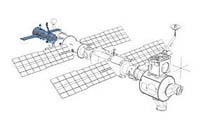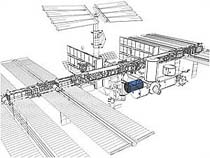| tec |
| | home | site map | about context | lang >>> español | |
| >>> context weblog | |
| technology > space > space station > iss | ||
|
november
2, 2000 |
|
iss, expedition 1 | |
|
|
||
|
::
|
international
cooperation In January 29, 1998, partners sign ISS agreements: United States - *NASA*, Europe - *ESA*, Japan - *NASDA*, Canada - *CSA*, Russia - *RSA*, and Brazil - *INPE* . A total of 16 states. These new agreements supersede previous Space Station agreements among the U.S., Europe, Japan and Canada signed in 1988. "These new *agreements* reflect changes to the Space Station program resulting from significant Russian participation in the program and program design changes undertaken by the original partnership in 1993." Russian Mir-2 project was replaced by participation in construction of the International Space Station. In Europe, eleven member states of the European Space Agency are participating in the programme: Belgium, Denmark, France, Germany, Italy, the Netherlands, Norway, Spain, Sweden, Switzerland, and United Kingdom. "As a community of nations whose economic strength and health is largely dependent on the production of advanced-technology products, Europe cannot afford to be absent from this high-technology programme from which important scientific, technological and political impulses are expected for the future." *Why is Europe participating in the International Space Station?*. what about mir? The 14-year-old Mir has outlived its planned shelf life, but its final fate has still not been decided. Russia stabilized Mir's orbit, removing the threat of the station's deorbiting (October 21 docking of Progress M-43 resupply spacecraft). Due to financial problems of Rusia, operation of Mir is seen as a competitor for the International Space Station for resources. "So there will have to be a transition to ISS and Mir will have to come down," said NASA official, Michael Faul. In October, Russian Deputy Prime Minister Ilya Klebanov made a statement about Mir's possible deorbiting next year. "However, if there are non governmental resources to finance the Mir station, it opens the possibility to change the situation." The fate of space station will be decided by mid February of 2001. *MirCorp*, was formed in February to develop commercial operations on Mir. MirCorp is 60% owned by RSC Energia the manufacturer and operator of Mir while the remaining 40% held by its financial investors. In June, Mir space station was declared ready for commercial flights. Between April and June, cosmonauts Sergei Zalyotin and Alexander Kalery completed their mission to reactivate the Mir space station for commercial activity. Was the first crew sent to space without government funding, the first operations on board a commercially funded space station and the first commercially sponsored spacewalk. "Mir was made in modules and eventually we will start building new ones. We can build a new module for $100 million, and replace the core module -which is 14 years old- in about two years. Then the average age of the Mir modules is five years old. We'd have a five-year-old station for about $250 million. Compare that with the $4 billion a year Boeing is getting for the International Space Station. But, of course, if you are Lockheed or Boeing or any other big contractor you have every reason to support the multibillion dollar space station contract. If an engineer said to the vice-chairman of Boeing, "I have a plan to keep Mir in orbit for $150 million," the guy is going to get thrown out of the door. If you are part of the status quo in the space business, you want Mir down." Jeffrey Manber, president of MirCorp talks to Hazel Muir -New Scientist magazine, 08 July 2000- *about Mir's future*. |
|
  |
||
|
|
||
|
source::
|
international
space station status report #00-48 <http://spaceflight.nasa.gov/spacenews/reports/issreports/ 2000/iss00-48.html> :: references NASA site on the International Space Station <http://spaceflight.nasa.gov/station/science/index.html> ESA - European Space Agency view on the International Space Station <http://www.estec.esa.nl/spaceflight/iss.htm> NASDA - National Advanced Space Development Agency of Japan <http://www.nasda.go.jp/index_e.html> CSA - Canadian Space Agency <http://www.space.gc.ca> RSA - Russian Space Agency <http://www.fas.org/spp/civil/russia/rsa.htm> INPE - Brazilian Space Agency <http://www.inpe.br> Partners Sign ISS Agreements <http://spaceflight.nasa.gov/station/reference/partners/special/ iss_aggrements/index.html> MirCorp <http://www.mirstation.com/about_who.html> Man on a mission. Jeffrey Manber, president of MirCorp talks to Hazel Muir. New Scientist magazine, 08 July 2000. <http://www.newscientist.com/nl/0708/manber.html> :: memory july 12, 2000 |, zvezda module in orbit. <http://www.straddle3.net/context/tec/t_000712.en.html> july 10, 2000 | watch iss construction on internet <http://www.straddle3.net/context/tec/t_000710.en.html> :: image International Space Station overview. Animation Still Image. two stills form Assembly Sequence <http://spaceflight.nasa.gov/gallery/images/station/lineart/ndxpage1.html> |
|
|
|
||
| | home | site map | about context | lang > español| | ||
context weblog >>>
http://www.straddle3.net/context